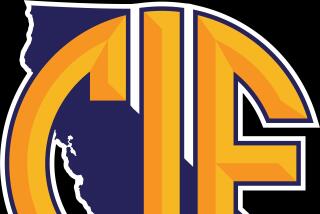Brand Urges Academic Reforms
Devoting extensive time during his first state-of-the-association speech to academic reform, NCAA President Myles Brand told a gathering of NCAA convention delegates Sunday, “I take as my first principle the conviction that intercollegiate athletics must be integrated into the academic mission of colleges and universities.”
If approved, reforms will include staggering penalties, such as postseason bans and reduced scholarships, for Division I teams that don’t meet standards.
The hard question that will linger when the estimated 1,800 delegates check out of their hotel rooms Tuesday is whether Brand’s grand plan will become a reality.
“It’s a fair question,” said Robert Hemenway, the Kansas chancellor who serves as chair of the NCAA board of directors. “No one has ever accused the NCAA of having a streamlined bureaucracy.”
Kevin Lennon, the NCAA vice president for membership services and resident expert on the association’s legislative process, acknowledges the concern that another smart idea will deteriorate amid bogged-down discussion, bickering and personal agendas.
“Myles has said the devil is in the details, and he’s right,” Lennon said. “We need to find agreement on so many points. The methodology we need to follow is to get as many people as possible comfortable and get them to understand what we are doing.”
That’s why Brand repeatedly urged consensus on the issue during his address at the Disneyland Hotel.
“We must adopt specific reforms that achieve the desired results without harmful, unintended consequences,” Brand said. “If we fail to approach the process carefully, misunderstanding, lack of commitment, and lack of ownership of these much-needed reforms will be the result of our inattention.”
Brand, the former Indiana president who became the first sitting president to ascend to the NCAA’s chief executive position, has several supporters among his peers.
John White, the Arkansas chancellor who is one of 18 members of the NCAA’s board of directors, said the future existence of Brand’s planned academic reforms are based “not on the whether, but the when.”
The board of directors already has approved sweeping changes that the executive committee turned into legislation. White said the adoption of a sliding scale for admission, which allows incoming student-athletes to establish eligibility with a 3.55 grade-point average -- no matter what they score on the SAT or ACT exam -- is an important first step that validates the idea that other meaningful, academic-themed measures can win approval.
Beginning in the 2003-04 academic year, incoming student-athletes will be required to maintain a prescribed path toward graduation. At the end of their second school year, the student-athletes must have 40% of their course work completed -- 60% after their third year and 80% after their fourth year. The requirements are based on a model for a student-athlete who uses a redshirt season (doesn’t participate in games) during one of his/her years. Those who aren’t making sufficient progress will be ineligible for game participation. Additionally, standards for reaching a minimum GPA (90% of the campus GPA in the second year of school, 95% in the third, 100% in the fourth) have been established.
Upon finalizing the legislation in October, Hemenway said, “If you don’t meet the academic profile, you won’t be participating in college sports.”
In a time when the NCAA, athletic departments and coaches have been grilled about exploiting athletes by being involved in multimillion-dollar television, endorsement and sponsorship deals, Arkansas’ White says stressing an academic enforcement plan is a heavy investment that strongly benefits the athletes.
“Monitoring progress toward a degree, in my opinion, is the strongest step we can take,” White said. “The truth is, the thing we are most obligated to do is to ensure our athletes are making satisfactory progress toward a degree.”
Brand has said the NCAA is working toward a system that will allow for quicker annual access to grades. There’s also a movement to increase the amount of core courses incoming student-athletes must complete in high school, from 14 to 16.
Beyond that, extensive time will be devoted this year to creating an incentive/disincentive model intended to force universities to be more accountable for their student-athletes’ classwork. Possible incentives, White said, include scholarships, revenue awards and improved postseason opportunity. It’s the disincentives, however, that are certain to inspire the most debate.
How the NCAA will punish those teams that aren’t meeting the established guidelines has yet to be determined, prompting Texas Athletic Director DeLoss Dodds to say, “All those little things worry me.” Dodds, chair of the Division I-A football issues committee, said he believes the best strategy would be to institute the rule for a few years before attaching the harsh penalties.
“I hate to jump right into this,” Dodds said. “Let’s see if the rule works.”
Brand and Hemenway attended an academic reform task force meeting Sunday, learning from committee members and hired consultants that a package of legislation, including incentives and disincentives, could be approved as soon as the 2004-05 school year.
“I don’t think we’re that far away,” Brand said. “We need to do things sequentially.”
Hemenway agreed, noting that the most hopeful sign of potential reform is that the powerful contingent of university presidents are heavily supportive of the general plan of reform, including the incentives and disincentives. School presidents dominate the board of directors and executive committee rosters.
“That sentiment will push this through,” Hemenway said. “I don’t have a crystal ball, but I do know there are a large number of presidents, chancellors and conference commissioners with a deep resolve to go forward on this.”
Michael Aguirre of the Student Athlete Advisory Committee is concerned with the lost-scholarships penalty, arguing that if one team loses one, two or five, another team or school should gain that same number so educational opportunities are not eliminated.
Assessing and finding solutions to such possible consequences are a must, even if they impede any hope of quick legislation.
Said Hemenway: “We have to touch all of those bases, no matter how tough they are to get to. We just can’t take 10 years to touch them all.”
More to Read
Go beyond the scoreboard
Get the latest on L.A.'s teams in the daily Sports Report newsletter.
You may occasionally receive promotional content from the Los Angeles Times.











